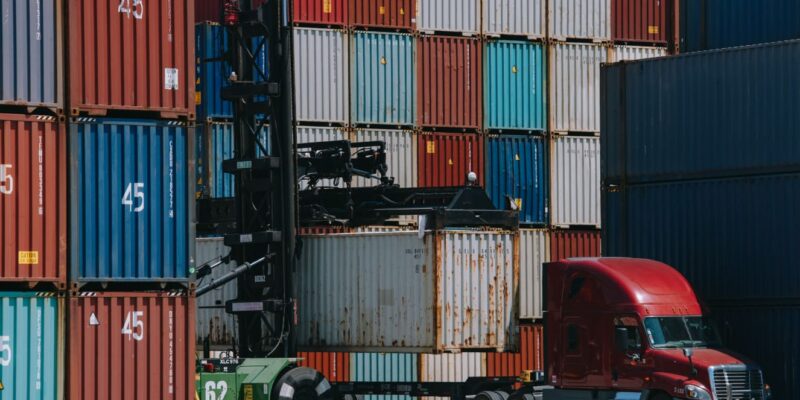A guide to freight shipping in 2024

In the dynamic world of global trade, the movement of goods and commodities is essential, with freight shipping serving as the backbone of this process. This guide is designed to demystify the complex logistics of freight shipping, catering to businesses of all sizes—from small enterprises dispatching packages to large corporations handling vast quantities of goods. Understanding the logistics, familiarizing with industry terminology, and identifying the right shipping solutions are critical for any business aiming to thrive in the international market.
Freight shipping involves the transportation of large or bulk volumes of products. It covers various distances, from short local deliveries to long international hauls. Unlike smaller parcel or package shipping, freight shipping is designed for heavier shipments. Specifically, it handles goods weighing over 150 pounds and can accommodate loads up to 15,000 pounds. This capability makes freight shipping a key component in the management of supply chains and in facilitating global trade.
How do freight shipments travel?
Freight shipments travel by five primary modes of transportation:
1. Road transportation
Road transportation refers to freight movement using motor vehicles on roads and highways. Road transportation is the most common mode of freight shipping due to its flexibility, accessibility, and cost-effectiveness. It is suitable for both short-distance and long-distance transportation within a country or across borders.
The types of trucks commonly used in road transportation are:
- Dry vans: These are enclosed trailers used for shipping dry goods such as electronics, clothing, and machinery.
- Refrigerated trucks: Also known as reefer trucks, they are used to transport temperature-sensitive cargo like food and pharmaceuticals.
- Flatbeds: These are open trailers with no roof or sides, making it easy to load and transport large or odd-sized items such as heavy equipment, building materials, and machinery.
Types of Shipments: Ideal for both FTL and LTL, flexible for short to medium distances.
- Pros:
- High flexibility in routes and scheduling.
- Ideal for door-to-door deliveries.
- Wide availability of providers.
- Cons:
- Susceptible to delays due to traffic and weather conditions.
- Limited by weight and size restrictions.
2. Rail transportation
Rail transportation is the movement of freight using trains on a network of rails or tracks and is widely used for long-distance and intermodal freight shipping.
Types of Shipments: Best for large, bulky goods and bulk commodities over long distances.
- Pros:
- Cost-effective for large shipments.
- Less affected by weather and traffic conditions compared to road transport.
- Eco-friendlier than road transport.
- Cons:
- Less flexibility in pickup and delivery points.
- Longer transit times than road transport.
3. Air freight
Air freight involves the transportation of goods via air carriers, including commercial airlines and dedicated cargo airlines. Air freight is best suited for time-sensitive or perishable shipments. It is also used for shipping high-value items such as electronics and pharmaceuticals.
Types of Shipments: High-value, perishable goods, or urgent shipments.
- Pros:
- Fastest transport method for long distances.
- Reliable and secure.
- Cons:
- Most expensive mode of transport.
- Subject to strict regulations and limited by airport locations.
4. Sea/ocean freight
Sea/ocean freight is the transportation of goods by ships across oceans and seas. Sea freight is commonly used for international shipments and transporting bulk commodities such as oil, ores, and grains. It is also utilized for intermodal shipping since large cargo can be loaded onto trains or trucks from ports.
Types of Shipments: Full-container load (FCL), Less-than-container load (LCL), Roll-on-roll-off (Ro-Ro), and Break-bulk.
- Pros:
- Cost-effective for bulk and heavy goods.
- Large capacity.
- Cons:
- Slowest mode of transport.
- Vulnerable to weather conditions and port delays.
5. Intermodal freight
Intermodal freight shipping is the practice of using more than one mode of transportation to move goods from origin to destination. Intermodal shipping offers a cost-effective and efficient option for moving large volumes of cargo. It combines the advantages of different modes of transport, such as rail’s long-distance hauling capabilities and trucking’s flexibility in pickup and delivery points.
Types of Shipments: Express intermodal, ocean intermodal, surface intermodal
- Pros:
- Offers a balance of speed, cost, and environmental benefits.
- Flexible and can be tailored to specific needs.
- Cons:
- Requires precise coordination.
- Potential for delays during mode transfers.
How to ship freight
Choosing a transportation mode
To begin with, determining specific shipping needs based on the freight’s origin, destination, and characteristics is essential. This initial step guides shippers in selecting the most suitable mode of transport, which can vary from single-mode to multi-modal options, combining air, sea, rail, and road transportation as well as LTL vs FTL shipping modes. The choice of transportation mode is influenced by factors such as the type of cargo, urgency, and cost-effectiveness, and is categorized into the segments listed here.
- LTL: Less than truckload (LTL) is utilized when shipping freight volume larger than parcel but not big enough to fill a full trailer. LTL freight shipping is employed for shipments ranging from 150 to 15,000 pounds.
- FTL: Full truckload (FTL) is used for both bulk loads or pallets that will fill up an entire trailer. These can be a minimum weight of 15,000 pounds. FTL is mostly utilized as long-haul and if the shipper has enough cargo to fill the entire trailer.
- Partial Truckload: Also referred to as consolidated shipping, this involves splitting the cost of a truck with other shippers to save costs and improve the use of available capacity. It’s used when a shipment is over 5,000 pounds or 6 pallets.
- Intermodal: Intermodal shipping seamlessly combines rail, truck, air, and ocean freight to move goods efficiently. By leveraging the strengths of each mode, it offers flexibility, cost-effectiveness, and environmental sustainability. This coordinated approach minimizes transit times, reduces costs, and lessens environmental impact. It is ideal for long-haul journeys and large-scale logistics operations.
- Expedited Freight: This type of transportation is generally employed to transport time-sensitive or spoilable cargo that has to be delivered as fast as possible. Accelerated freight traditionally involves air transport or trucks.
After identifying the appropriate mode of transport, the next critical phase involves preparing the necessary shipping documents. This step is pivotal in ensuring a smooth transition to the actual movement of freight.
Preparing shipping documents
Effective management of essential documents, including the bill of lading, freight bill, packing list, and commercial invoice, ensures efficient shipping operations when transporting freight. Failure to organize these documents properly could result in delays, penalties, late fees, or additional costs.
Here is a list of the essential shipping documents shippers might need when shipping freight:
- Bill of Lading (B/L): This document sets the terms between shippers and the transportation company.
- House Air Waybill (HAWB): Identifies a single shipment.
- Master Air Waybill (MAWB): Used for consolidating several house air waybills.
- Sea Waybill: Acts as a contract of carriage and receipt of goods.
- Commercial Invoice: Details the transaction and is vital for duties and taxes.
- Shipper’s Letter of Instruction (SLI): Instructs how the shipment is handled.
- Electronic Export Information (EEI): Required for US exports over US$2,500.
- Certificate of Origin: Defines the goods’ origin.
- Hazardous Materials/ Dangerous Goods (HAZMAT): Required for substances posing risks during transport.
Packaging freight
Packaging is a critical element when shipping freight. It ensures cargo reaches the final destination in peak condition. Various types of packaging, including pallets, crates, drums, and shipping containers, offer different levels of protection and suitability for different types of cargo. Logistics teams also need to factor in proper cushioning, dunnage, and protective materials like bubble wrap or foam padding when transporting freight. By investing in quality packaging, shippers can reduce the risk of costly accidents and delays during freight shipping quotes.
Calculating freight costs
Various freight factors impact how freight costs are calculated.
- Weight and Volume: The weight and volume of the cargo directly impact transportation costs. Freight rates are often based on weight, with heavier shipments costing more to transport. Additionally, bulky or oversized cargo may require specialized handling and equipment, leading to higher shipping costs.
- Freight class: For less than truckload (LTL) shipments, freight class plays a significant role in determining costs. The National Motor Freight Classification (NMFC) system assigns a freight class to goods based on factors such as density, stowability, handling, and liability. Each freight class has its own pricing structure, with higher classes generally commanding higher shipping rates. Shippers can determine a cargo’s freight class by using Uber Freight’s Density Calculator.
- Urgency: How quickly freight is needed to ship and reach the destination impacts both modes of transportation and the cost of freight. Shippers will likely pay higher costs when freight needs to ship urgently. Planning freight shipping can help optimize costs and ensure reliable transportation.
- Mode of Transportation: Typically, air freight is acknowledged as the priciest mode of transportation, while ocean freight is the most economical. Shippers have the opportunity to enhance both speed and cost-effectiveness by selecting intermodal modes. Moreover, if freight necessitates specialized handling, such as temperature control, shipping expenses may also escalate.
- Distance: The farther the distance a shipment needs to travel, the higher the freight cost is likely to be due to the increased fuel, labor, and equipment expenses associated with longer journeys. Moving freight between two locations is not always a straight line, and thus optimizing the route is crucial to keeping shipping costs in control. An experienced 3PL can help shippers optimize shipping in this case.
- Seasonality: Seasonality can lead to fluctuations in freight costs due to changes in demand, capacity constraints, weather conditions, fuel prices, and operational challenges. Shippers should anticipate seasonal variations and plan their logistics and supply chain strategies accordingly to mitigate the impact on freight costs.
By understanding the key factors that impact freight costs, shippers can make informed decisions to optimize their logistics and supply chain strategies. Keep in mind that freight costs can vary based on numerous factors, so it’s essential to obtain rate quotes and consider all relevant factors before finalizing shipping arrangements.
Insuring freight
Insuring cargo against loss or damage is important to protect shipping businesses from unforeseen circumstances. Cargo insurance coverage options vary in scope and cost, ranging from basic liability coverage to comprehensive cargo insurance policies. Freight and carrier liability insurance covers several shipping needs, but does not cover concealed damages or losses due to inadequate packing. Insurance can give shippers peace of mind and financial security in the event of a mishap.
Booking Freight
Scheduling a pickup is the final step in the freight shipping process. It involves arranging for the carrier to pick up the cargo at a specific time and location. Before this, it’s crucial to get quotes and select a suitable carrier based on specific shipping needs and budget. This can be done through various methods such as phone, email, or online freight shipping services platforms like Uber Freight’s Shipper Platform.
When scheduling a pickup, make sure to provide detailed information about the shipment, including dimensions, weight, and any special handling instructions. This will help ensure a smooth pickup process and avoid any delays or additional fees. It is also important to communicate with the carrier about any specific requirements, such as loading/unloading procedures or time constraints at the pickup location.
Tracking freight
Throughout the process of freight shipping, it’s important to stay aware of where the freight is at all times before delivery. Visibility into freight movement helps improve operational efficiency, enabling shippers to reroute shipments, ensure documents are in order, and check up on freight status. Real-time freight tracking and visibility solutions like Uber Freight’s Shipper Platform can help shippers stay on top of their transportation game.
Tech tools like Transportation Management Systems offer deep, granular awareness of shipments in real-time. These systems give shippers access to several tools for managing freight transportation, including route optimization, load planning, carrier selection, and performance monitoring. For instance, Uber Freight’s TMS solution provides shippers with easy tools and the technology needed to automate and optimize their logistics processes, improving efficiency and reducing costs.
Choosing a freight shipping company
Choosing the right company based on transportation needs is crucial. Shippers can shortlist and select freight shipper partners to suit their unique requirements by looking into aspects like:
- Transportation modes offered
- Service areas
- Technology capability
- Cargo handling capability
Our freight shipping services platform stands out for its user-friendly interface and comprehensive suite of digital tools, empowering shippers to manage logistics operations with ease and efficiency.
Shipping freight with Uber Freight
Whether you’re a small business or a large enterprise, we have the software and solutions that you can tailor to your business’s freight shipping needs. Our unique combination of expert-led partnerships, leveraging AI-assisted intel, and the largest capacity marketplace, delivers next-generation logistics across the supply chain.
Sign up on Shipper Platform to book a load today or connect with one of our experts to learn how we can help you make the most of your logistics and transportation operations.



